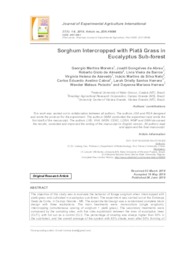Sorghum intercropped with Piatã Grass in eucalyptus sub-forest.
Sorghum intercropped with Piatã Grass in eucalyptus sub-forest.
Autoria: MOREIRA G. M.; ABREU, J. G. de; ALMEIDA, R. G. de; BARROS, L. V. de; AZEVEDO, V. H. de; SILVA NETO, I. M. da; CABRAL, C. E. A.; HERRERA, L. D. S.; PEIXOTO, W. M.; HERRERA, D. M.
Resumo: The objective of this study was to evaluate the behavior of forage sorghum when intercropped with piatã grass and cultivated in eucalyptus sub-forest. The experiment was carried out at the Embrapa Gado de Corte, in Campo Grande - MS. The experimental design was a randomized complete block design with three replications. The main treatments were: monoculture (single sorghum); intercropping (simultaneous sowing of sorghum + piatã grass). The secondary treatments were composed by the sampling sites, with five sites equidistant between the rows of eucalyptus trees (CLFI), with full sun as a control (CLI). The percentage of shading was always higher than 30% in the sub-forest, and the overall average of the system with 63% shade, even after 50% thinning of eucalyptus trees. The intercropping with the grass, an interesting fact, did not affect sorghum grain yield, since it validates the potential of forage sorghum for use in intercropping with perennial grasses, with average grain yield of 2,404.63 kg ha-1. Regarding the sampling sites, it was observed a higher yield in the full sun with 3,283 kg ha-1. The weight of 100 grains was higher for sorghum in monoculture. On the other hand, the upper W1000 was observed at sites A and C. The weight of 1000 grains is considered stable, being affected only under conditions of stress during grain formation. The sorghum intercropped with the piatã grass did not influence the harvest index (HI), while in the shaded environment there was an increase in the harvest index in relation to the full sun.
Ano de publicação: 2019
Tipo de publicação: Artigo de periódico
Unidade: Embrapa Gado de Corte
Palavras-chave: Capim piatã, Eucalipto, Eucalyptus, Eucalyptus urograndis, Grain sorghum, Monocultura, Sorghum Bicolor, Sorgo, Sorgo Forrageiro, Urochloa brizantha
Observações
1 - Por padrão são exibidas publicações dos últimos 20 anos. Para encontrar publicações mais antigas, configure o filtro ano de publicação, colocando o ano a partir do qual você deseja encontrar publicações. O filtro está na coluna da esquerda na busca acima.
2 - Para ler algumas publicações da Embrapa (apenas as que estão em formato ePub), é necessário ter, no celular ou computador, um desses softwares gratuitos. Sistemas Android: Google Play Livros; IOS: iBooks; Windows e Linux: software Calibre.
Acesse outras publicações
Acesse a Base de Dados da Pesquisa Agropecuária (BDPA) para consultar o acervo completo das bibliotecas da Embrapa.

